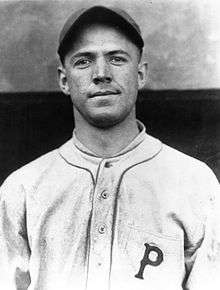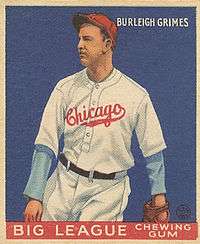Burleigh Grimes
Burleigh Arland Grimes (August 18, 1893 – December 6, 1985) was an American professional baseball player, and the last pitcher officially permitted to throw the spitball.[1][2][3] Grimes made the most of this advantage, winning 270 games, and pitched in four World Series over the course of his 19-year career.[4] He was elected to the Wisconsin Athletic Hall of Fame in 1954, and to the Baseball Hall of Fame in 1964.[4]
| Burleigh Grimes | |||
|---|---|---|---|
 circa 1916, with Pittsburgh | |||
| Pitcher / Manager | |||
| Born: August 18, 1893 Emerald, Wisconsin | |||
| Died: December 6, 1985 (aged 92) Clear Lake, Wisconsin | |||
| |||
| MLB debut | |||
| September 10, 1916, for the Pittsburgh Pirates | |||
| Last MLB appearance | |||
| September 20, 1934, for the Pittsburgh Pirates | |||
| MLB statistics | |||
| Win–loss record | 270–212 | ||
| Earned run average | 3.53 | ||
| Strikeouts | 1,512 | ||
| Managerial record | 131–171 | ||
| Winning % | .434 | ||
| Teams | |||
As player
As manager | |||
| Career highlights and awards | |||
| |||
| Member of the National | |||
| Induction | 1964 | ||
| Election Method | Veterans Committee | ||
Early life
Born in Emerald, Wisconsin, Grimes was the first child of Nick Grimes, a farmer and former day laborer, and the former Ruth Tuttle, the daughter of a former Wisconsin legislator. Having previously played baseball for several local teams, Nick Grimes managed the Clear Lake Yellow Jackets and taught his son how to play the game early in life.[5] Burleigh Grimes also participated in boxing as a child.[6]
He made his professional debut in 1912 for the Eau Claire Commissioners of the Minnesota–Wisconsin League.[7] He played in Ottumwa, Iowa, in 1913 for the Ottumwa Packers in the Central Association.
MLB career

Grimes played for the Pittsburgh Pirates in 1916 and 1917. Before the 1918 season, he was sent to the Brooklyn Dodgers in a multiplayer trade.[8] When the spitball was banned in 1920, he was named as one of 17 established pitchers who were allowed to continue to throw the pitch. According to Baseball Digest, the Phillies were able to hit him because they knew when he was throwing the spitter.
He then pitched for the New York Giants (1927), the Pirates again (1928–1929), the Boston Braves (1930) and the St. Louis Cardinals (1930-1931). He was traded to the Chicago Cubs before the 1932 season in exchange for Hack Wilson and Bud Teachout.[9] He returned to the Cardinals in 1933 and 1934, then moved to the Pirates (1934) and the New York Yankees (1934). Grimes was nicknamed "Ol' Stubblebeard", related to his habit of not shaving on days in which he was going to pitch.[10]
Grimes was a very good hitting pitcher in his major league career, posting a .248 batting average (380-for-1535) with 157 runs, 62 doubles, 11 triples, 2 home runs and 168 RBI. He also drew 69 bases on balls. He had nine seasons with 10 or more RBIs, with a high of 16 in 1920 and 1928. In four World Series appearances (1920, 1930-1932) he hit .316 (6-for-19) with 1 run and 2 RBI.
At the time of his retirement, he was the last player who was legally allowed to throw a spitball, as he was one of 17 spitballers permitted to throw the pitch after it was otherwise outlawed in 1920. He had acquired a lasting field reputation for his temperament. He is listed in the Baseball Hall of Shame series for having thrown a ball at the batter in the on-deck circle.[11] His friends and supporters note that he was consistently a kind man when off the diamond. Others claim he showed a greedy attitude to many people who 'got on his bad side.' He would speak mainly only to his best friend Ivy Olson in the dugout, and would pitch only to a man named Mathias Schroeder before games. Schroeder's identity was not well known among many Dodger players, as many say he was just 'a nice guy from the neighborhood.'
Grimes had a total of 36 Major League teammates who would later be elected to the Hall of Fame. No other Hall of Famer had more Hall of Fame teammates.[12]
Post-playing career
Grimes moved to the minor leagues in 1935 as a player-manager for the Bloomington Bloomers of the Illinois–Indiana–Iowa League. He started 21 games for the team, recording a 2.34 ERA and a 10-5 record.[13] He did not pitch again after that season, moving on to manage the Louisville Colonels of the American Association.[13]
Grimes was the manager of the Dodgers in 1937-38. He followed Casey Stengel's term as Dodgers manager.[14] He compiled a two-year record of 131-171 (.434), with his teams finishing sixth and seventh respectively in the National League. Babe Ruth was one of Grimes's coaches. Leo Durocher was the team's shortstop in 1937 and a coach in 1938.[15] When Grimes was fired by general manager Larry MacPhail after the 1938 season, Durocher was hired to replace him. MacPhail said the team's morale had not been right for a long period of time.[16]
Grimes remained in baseball for many years as a minor league manager and a scout.
He managed the Toronto Maple Leafs of the International League from 1942 to 1944, and again in 1952 and 1953, winning the pennant in 1943.
As a scout with the Baltimore Orioles, Grimes discovered Jim Palmer and Dave McNally.[15]
Grimes also assisted in managing the Independence Yankees in Independence, Kansas in 1948 and 1949, where Mickey Mantle started his professional career in 1949.[17]
Later life
Grimes was elected to the Baseball Hall of Fame in 1964. In 1981, Lawrence Ritter and Donald Honig included Grimes in their book The 100 Greatest Baseball Players of All Time.[18]
Grimes died of cancer at age 92 in 1985 in Clear Lake, Wisconsin. His wife Lillian survived him.[14] He is buried at the cemetery in Clear Lake.
See also
Notes
- Burns, Edward (September 18, 1931). "Grimes says he's woodsman; others say he's great hurler". Chicago Daily Tribune. p. 27.
- Weiskopf, Herman (July 31, 1967). "The Infamous Spitter". Sports Illustrated. p. 12.
- Wolf, Steve (April 13, 1981). "Tricks of the Trade". Sports Illustrated. p. 92.
- Guzzardi, Joe (April 3, 2016). "Burleigh Grimes, the last great spit-baller". Pittsburgh Post-Gazette. Retrieved March 7, 2017.
- Niese, p. 10.
- Niese, p. 12.
- Christofferson, Jason. Diamonds in Clear Water: Professional Baseball in Eau Claire, 1886–1912. Self-published. 2013. p.143-155.
- "Robins give Pirates two players for three in big trade; Mamaux obtained by Robins in deal". The New York Times. January 10, 1918. Retrieved November 2, 2014.
- Snyder, John (2010). Cardinals Journal: Year by Year and Day by Day with the St. Louis Cardinals Since 1882. Clerisy Press. ISBN 157860480X. Retrieved November 2, 2014.
- "Grimes, Burleigh". Baseball Hall of Fame. Retrieved November 1, 2014.
- Bruce Nash, The Baseball Hall of Shame 2
- Stark, Jayson (January 15, 2009). "Three Strikes: A whole lot more of Rickey". ESPN. Retrieved 16 September 2019.
- "Burleigh Grimes Minor League Statistics & History". Baseball-Reference.com. Retrieved December 4, 2014.
- Yannis, Alex (December 10, 1985). "Burleigh Grimes, ex-pitcher and Hall of Fame member". The New York Times. Retrieved November 1, 2014.
- "Grimes back at "home"". Milwaukee Sentinel. February 4, 1972. Retrieved December 4, 2014.
- ""Lippy" peps up Dodgers". Pittsburgh Press. October 13, 1938. Retrieved December 4, 2014.
- Niese, Joe (2013). Burleigh Grimes: Baseball's Last Legal Spitballer. McFarland & Company. ISBN 978-1-4766-0179-3.
- (1981 photo)
References
- Niese, Joe (2013). [Burleigh Grimes: Baseball's Last Legal Spitballer https://books.google.com/books?id=6QKTmVNGltIC]. McFarland. ISBN 0786473282.
External links
- Career statistics and player information from Baseball-Reference, or Fangraphs, or Baseball-Reference (Minors)
- Burleigh Grimes managerial career statistics at Baseball-Reference.com
- cmgworldwide.com Official website
- Burleigh Grimes at Find a Grave

- Burleigh Grimes Oral History Interview (1 of 2) - National Baseball Hall of Fame Digital Collection
- Burleigh Grimes Oral History Interview (2 of 2) - National Baseball Hall of Fame Digital Collection